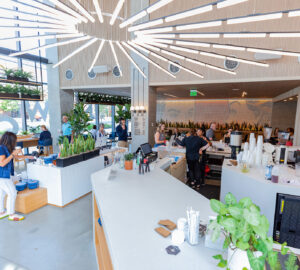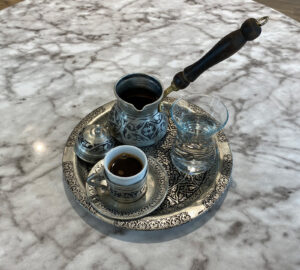Have you ever found yourself thinking, “This light-roasted coffee is just too dark for me?” or, “This barely-roasted coffee would be better if it were more caffeinated than normal coffee?” If so, you might want to check out white coffee, a very-very-very light roast approach to coffee that maintains a niche—but steady—following.
While some people use “white coffee” to describe a traditionally roasted coffee that’s simply served milky, in this article we’re going to delve into the white coffee that refers specifically to the roast level of the coffee bean, leaving the finished product closer to white (really, more of an ecru) than brown.
Where did white coffee come from? Was somebody’s roaster broken?
White coffee is said to have its origins in Yemen, where the mixture of ultra-lightly-roasted coffee and spices is a traditional way to consume coffee. The light roasting of the beans themselves may be done at home in a pan mixed with grains and spices. Yemeni white coffee may then be brewed and served with a sweet spice mixture called hawaij, which contains some variety of cinnamon, ginger, cardamom, mace, cloves, nutmeg, and so on. Wait—did Yemen actually invent the PSL?
What does white coffee taste like?
White coffee can have a nutty, herbaceous flavor profile, absent the usual cozy, caramelized-sugar notes we’re accustomed to in fully roasted coffee. As such, most places that serve white coffee often add quite a bit of accoutrement—just as in Yemen.
One of the biggest coffee companies to popularize white coffee in the United States is the Dutch Bros chain. The company recommends its popular white coffee in formats like the White Coffee Coconut Chai Latte, the White Coffee Dutch Crunch Breve, and the White Coffee Jelly Donut Oat Milk Latte (with pumps of raspberry, salted caramel, and almond flavoring—no actual donuts are harmed.) Want something simpler? “As a matter of taste preference, the possibilities are endless,” says Dutch Bros Roasting Production Supervisor Marshall Mcalpine, who assures Sprudge that any espresso-based drink at Dutch Bros can be made with a shot of white coffee.
“The simplest way to drink it would be as an Americano—yes, you can still order it black,” says Mcalpine, “but I wouldn’t personally recommend it.” Instead, he says, most customers who prefer a more basic white coffee prefer to enjoy it as a shot served over milk or a milk alternative.
How much caffeine is in white coffee?
For many, the purported caffeine superdose of white coffee is part of its great appeal—though how much actual difference in caffeine content takes place between a “white” roast and a typical light or medium roast is up for debate. Sprudge found multiple online coffee retailers claiming their white coffee had at least 50% more caffeine than regular roasts, but actual science suggests only about a 5% drop in caffeine content from unroasted to dark-roasted coffee beans.
Still, the perception that white coffee is an ultra-high-octane brew is clearly part of its marketing appeal. Tami Canaday of Denver’s Wagon Coffee, which serves a white-roasted Brazilian coffee, says she receives a lot of buzzed feedback from her white coffee clientele (including, she says, a drug recovery fellowship that meets at her cafe that “will swear it gives them a lot more energy and power.”)
But isn’t white coffee too hard (like, literally too hard) to grind in a standard coffee grinder?
Grinding white coffee would likely be too traumatic for a home grinder, or for a grinder with ceramic burrs. According to Lena Battegay, Head of Group Marketing for the Mahlkönig/Hemro brands, barely-roasted coffee is harder and less brittle than traditionally roasted coffee, so it’s more difficult for a lot of grinders to break down. “Also, the beans are denser,” she says, “Almost as hard as pebble stones.”
“This hardness affects both the motor and burrs,” says Battegay. “Due to the non-elastic properties of ceramic, the likelihood of breakage increases for ceramic burrs, whereas with steel burrs this is not a concern.” (Battegay assures Sprudge that all her company’s brands feature steel burrs made in Germany.) Lastly, she notes that “some grinders won’t have enough torque to spin, and the lifetime will drastically decrease.”
In order to keep up with their own white coffee demand, Dutch Bros. found it necessary to redesign whole process systems, as grinding white coffee with their burr grinders was “creating bottlenecks and inefficiencies in our production,” says Mcalpine. (They’ve since switched to a roller-style grinder, which offers faster output while keeping particle size consistent. The ground white coffee is then shipped to their cafes, ready-to-brew.)
What are the benefits of white coffee? (Why would I drink this?)
Besides the dubious perception that white coffee has an astronomical caffeine content, many people also believe white coffee keeps more of the beneficial chlorogenic acids of coffee than roasted versions retain. Unrelated to those particular acids, though, white coffee is also considered “lower-acidity” and supposedly easier on the digestion. Bear in mind that as white coffee is of limited popularity, most of these claims are not particularly well-researched yet—which is to say, if you are drinking white coffee only for health, you might just consider switching to tea.
Liz Clayton is the associate editor at Sprudge Media Network. Read more Liz Clayton on Sprudge.































